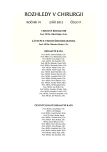Pharmacological influencing of abdominal aortic aneurysm model – animal experimental study, primary results
Authors:
K. Houdek 1; J. Moláček 1; V. Třeška 1; Z. Tonar 2; V. Křížková 2; L. Eberlová 2; J. Baxa 3; J. Kobr 4
Authors‘ workplace:
Chirurgická klinika LF UK a FN v Plzni, přednosta: Prof. MUDr. V. Třeška, CSc.
1; Ústav histologie a embryologie LF UK v Plzni, vedoucí: Doc. MUDr. M. Králíčková, Ph. D.
2; Klinika zobrazovacích metod LF UK a FN v Plzni, přednosta: Doc. MUDr. B. Kreuzberg, CSc.
3; Dětská klinika LF UK a FN v Plzni, přednosta: Doc. MUDr. J. Kobr, Ph. D.
4
Published in:
Rozhl. Chir., 2012, roč. 91, č. 9, s. 475-480.
Category:
Original articles
Práce vznikla v rámci programového projektu lékařského výzkumu a vývoje podpořeného IGA MZ. Číslo projektu: NS10235-3/2009
Overview
Introduction:
The aim of our work was to influence growth and histological changes in the wall of an experimentally induced aneurysm of the abdominal aorta in a large laboratory animal (domestic pig) by administering atorvastatin (3-hydroxy-3-methylglutaryl-coenzyme A reductase inhibitor).
Material and methods:
Within the scope of the above mentioned experimental work, we compared the growth rate of the aneurysm between the group influenced by statin administration (n=14) and the group without any pharmacological treatment (n=13). We also compared histological changes in the structure of the aortic wall in both groups with aneurysm and the wall of the aorta without aneurysm (n=6).
Results:
During the 4-week follow-up, we did not prove a statistically significant difference in the growth rate of aneurysms between the above mentioned groups. The histological structure of the aneurysm walls, however, differed between the two groups. The structure of the wall in the group of animals influenced by statin administration resembled the structure of the aortic wall without aneurysm.
Conclusion:
The results presented demonstrate that statins do influence the composition of the aortic wall. In our opinion, the administration of statins could lead to changes resulting in a more stable aneurysmatic wall. We believe that patients with smaller aneurysms who are not indicated for surgery or endovascular treatment could be treated with statins. Stabilization of the aneurysmal wall could slow down the growth of the aneurysm and prevent its rupture.
Key words:
Aneurysm – statins – experimental model
Sources
1. Treska V, Kocova J, Boudova L et al. Inflammation in the wall of abdominal aortic aneurysm and its role in the symptomatology of aneurysm. Cytokines Cell Mol Ther 2002;7:91–97.
2. Michel JB, Martin-Ventura JL, Egido J et al. FAD EU consortium: Novel aspects of the pathogenesis of aneurysms of the abdominal aorta in humans. Cardiovasc Res 2011;90:18–27.
3. Wilson WR, Evans J, Bell PR et al. HMG-CoA reductase inhibitors (statins) decrease MMP-3 and MMP-9 concentrations in abdominal aortic aneurysms. Eur J Vasc Endovasc Surg 2005;30: 259–262.
4. Sluijter JP, de Kleijn DP, Pasterkamp G. Vascular remodeling and protease inhibition – bench to bedside. Cardiovasc Res 2006;69:595–603.
5. Moll FL, Powell JT, Fraedrich G et al. Management of abdominal aortic aneurysms clinical practice guidelines of the European society for vascular surgery. Eur J Vasc Endovasc Surg 2011;41:S1–S58.
6. Gajendragadkar PR, Cooper DG, Walsh SR et al. Novel uses for statins in surgical patients. Int J Surg 2009;7:285–290.
7. Shiraya S, Miyake T, Aoki M et al. Inhibition of development of experimental aortic abdominal aneurysm in rat model by atorvastatin through inhibition of macrophage migration. Atherosclerosis 2009;202:34–40.
8. Moláček J, Třeška V, Kobr J et al. Optimization of the model of abdominal aortic aneurysm – experiment in an animal model. J Vasc Res 2009;46:1–5.
9. Briones AM, Rodríguez-Criado N, Hernanz R et al. Atorvastatin prevents angiotensin II-induced vascular remodeling and oxidative stress. Hypertension 2009;54:142–149.
10. Kočová J. Overall staining of connective tissue and the muscular layer of vessels. Fol Morphol 1970;18:293–295.
11. Tonar Z, Witter K, Křížková V et al. Stereological tools for quantitative microscopy of the aortic wall with focus on the abdominal aortic aneurysma. In: Méndez-Vilas A, Díaz J (Eds.). Microscopy: Science, Technology, Applications and Education. Applications in Biology and Medicine. Formatex Research Centre, Badajoz 2010:926–935.
12. Witter K, Tonar Z, Matějka VM et al. Tissue reaction to three different types of tissue glues in an experimental aorta dissection model: a quantitative approach. Histochem Cell Biol 2010;133: 241–259.
13. Hoegh A, Lindholt JS. Basic science review. Vascular distensibility as a predictive tool in the management of small asymptomatic abdominal aortic aneurysms. Vasc Endovascular Surg 2009;43:333–338.
14. Wagner RJ, Martin KA, Powell RJ et al. Lovastatin induces VSMC differentiation through inhibition of Rheb and mTOR. Am J Physiol Cell Physiol 2010;299:C119–127.
Labels
Surgery Orthopaedics Trauma surgeryArticle was published in
Perspectives in Surgery

2012 Issue 9
Most read in this issue
- A giant gastrointestinal stromal tumour – a case report
- Diverticulum of the greater curvature of the stomach as a cause of anaemisation
- The development of surgical treatment in liver and biliary tract diseases
- SILS appendectomy for acute appendicitis – two-year experience
